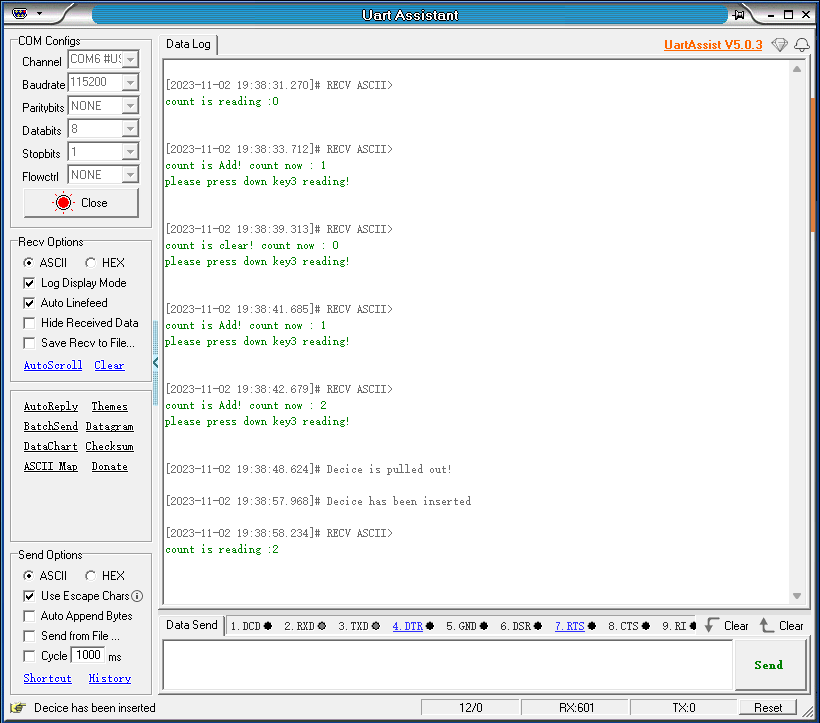On-chip Flash
On-chip Flash1、Software-Hardware2、Brief principle2.1、Hardware schematic diagram2.2、Physical connection diagram2.3、Principle of control3、Engineering configuration3.1、Notes3.2、Pin configuration4、Main function4.1、User function4.2、HAL library function parsing5、Experimental phenomenon
This tutorial demonstrates how to control the internal Flash of the development board to read and write data through keys , and print the data through the serial port (USART1)
1、Software-Hardware
STM32F103CubeIDE
STM32 robot expansion board
USART, internal Flash: chip internal peripherals
Key: Onboard
Type-C cable or ST-Link
Download or simulate the program of the development board
2、Brief principle
2.1、Hardware schematic diagram
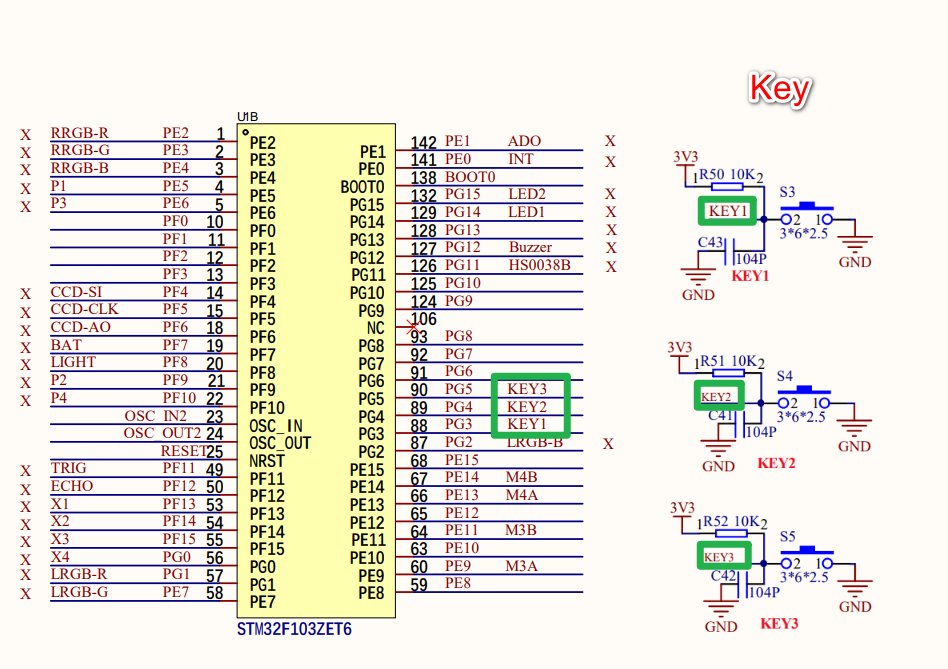
2.2、Physical connection diagram
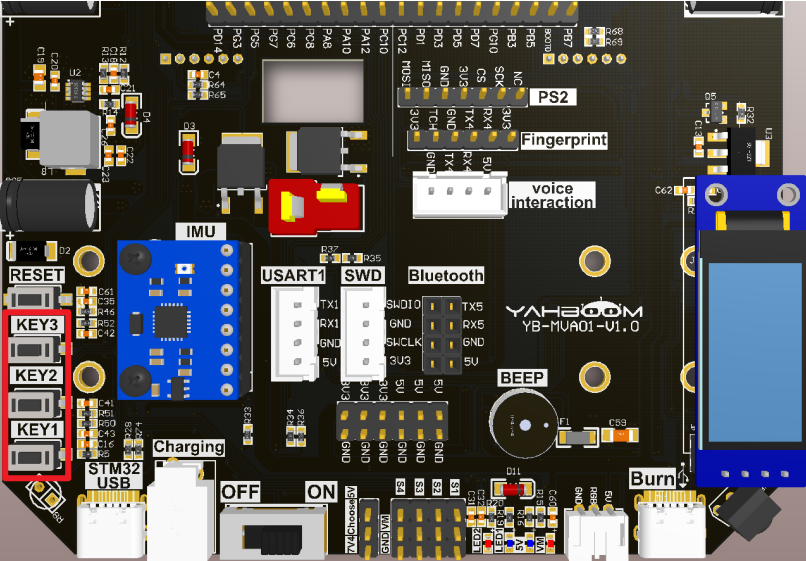
2.3、Principle of control
Use the keys to control the data written and read in flash, and print the data out through the serial port.
- GPIO reading
By defining different functions for the key, the data read and write operation in flash is realized.
| KEY(Schematic name) | Control pin | Function |
|---|---|---|
| KEY1 | PG3 | Add 1 to the count |
| KEY2 | PG4 | The count is cleared to zero |
| KEY3 | PG5 | Reading count values |
- Flash
STM32F103ZET6 Flash memory capacity is 512K bytes, a total of 256 2K byte pages;
Flash memory is mainly used to store program code and constant data in order to retain these data when restarted after power failure.
| Programming and erasing flash memory | register | Function |
|---|---|---|
| The FPEC key register | FLASH_KEYR | Used to erase and program Flash memory unlocking and locking |
| Select the byte key register | FLASH_OPTKEYR | Option bytes used to unlock and lock the Flash memory |
| Flash memory control registers | FLASH_CR | Used to control Flash memory programming and erase operations |
| Flash memory status register | FLASH_SR | Used to report Flash memory status information |
| Flash address register | FLASH_AR | Used to specify the address of Flash memory to be programmed or erased |
| Select the byte register | FLASH_OBR | The value used to store the option bytes |
| Write the protected register | FLASH_WRPR | Used to specify that Flash memory sectors are write-protected to prevent accidental modification. |
For detailed information, refer to "PM0042_STM32F10xxx Flash Memory Programming (Chinese)".
- Flsah write
Unlock → erase → write data → lock
| operation | function |
|---|---|
| Unlock | HAL_FLASH_Unlock |
| erase | HAL_FLASHEx_Erase |
| write data | HAL_FLASH_Program |
| lock | HAL_FLASH_Lock |
3、Engineering configuration
Project Configuration: Prompts for configuration options in the STM32CubeIDE project configuration process
3.1、Notes
Omitted project configuration: New project, chip selection, project configuration, SYS for pin configuration, RCC configuration, clock configuration, and project configuration content
The project configuration part, which is not omitted, is the key point to configure in this tutorial.
xxxxxxxxxxPlease refer to [2. Development environment construction and use: STM32CubeIDE installation and use] to understand how to configure the omitted parts of the project.
3.2、Pin configuration
- Configure the specified pin function
You can directly select the corresponding pin number in the pin view, and the corresponding option will appear when the mouse is left clicked
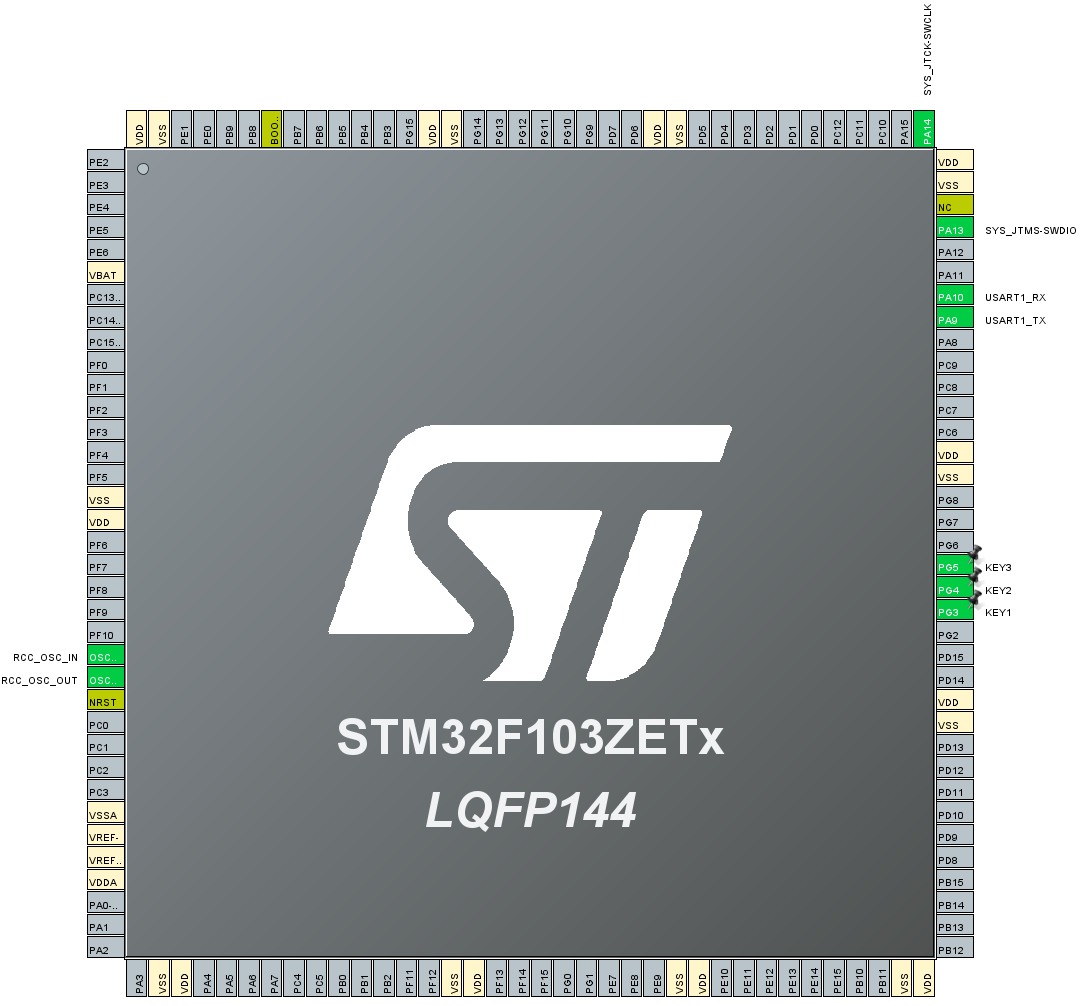
- GPIO
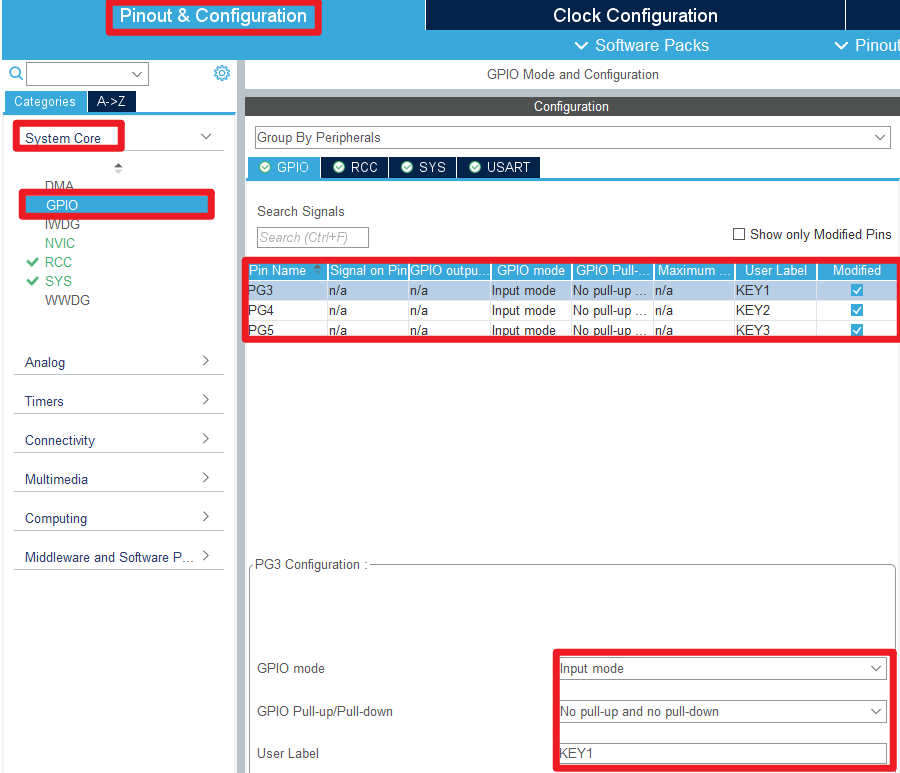
- USART
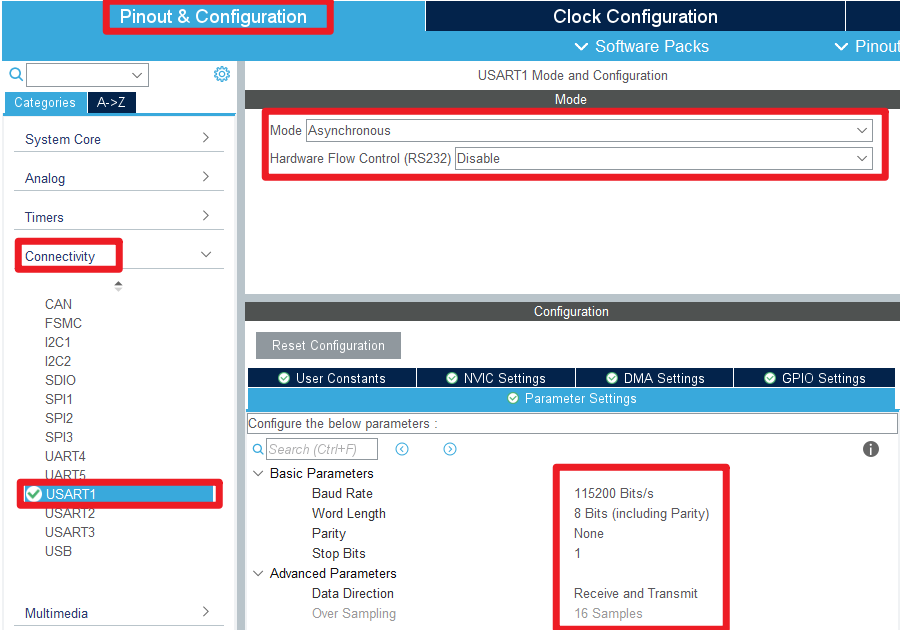
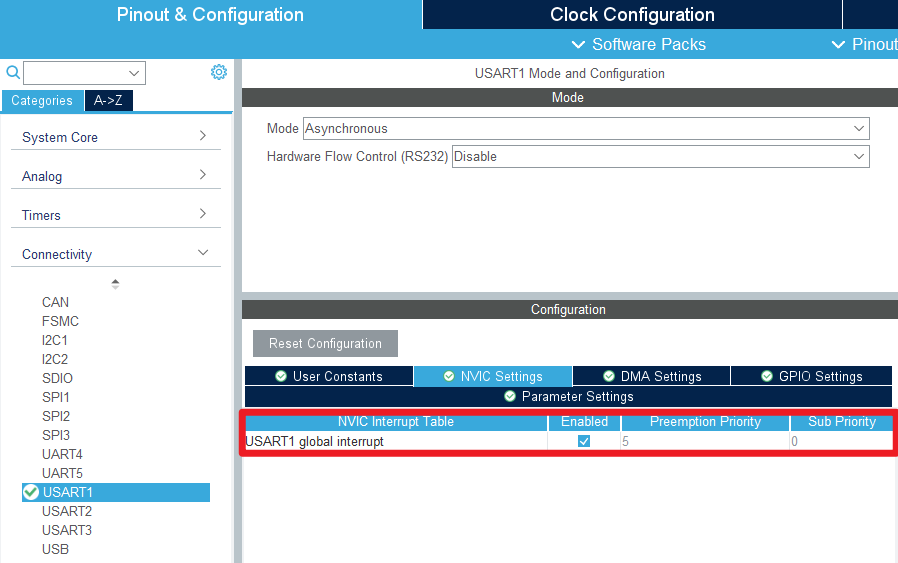
NVIC
NVIC can modify interrupt priority
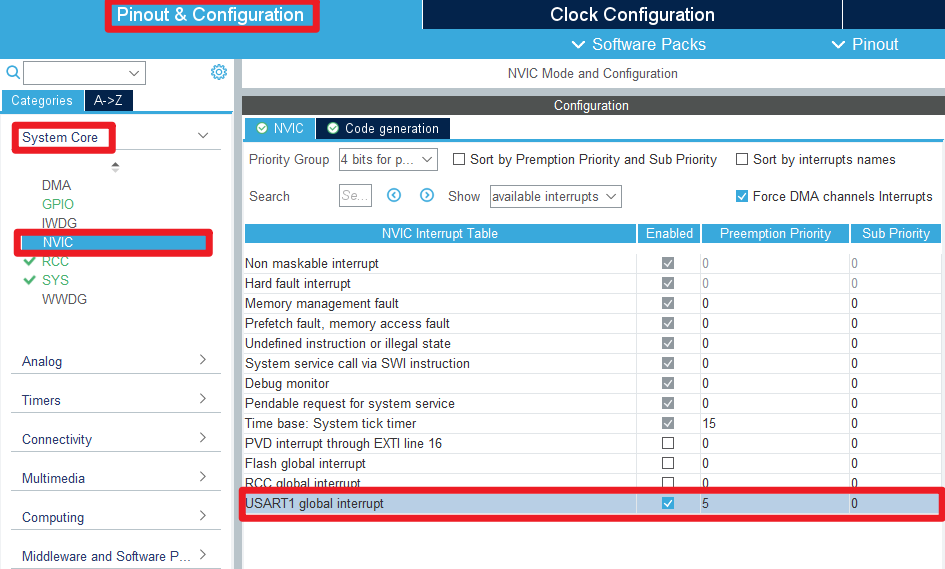
- Advanced Settings
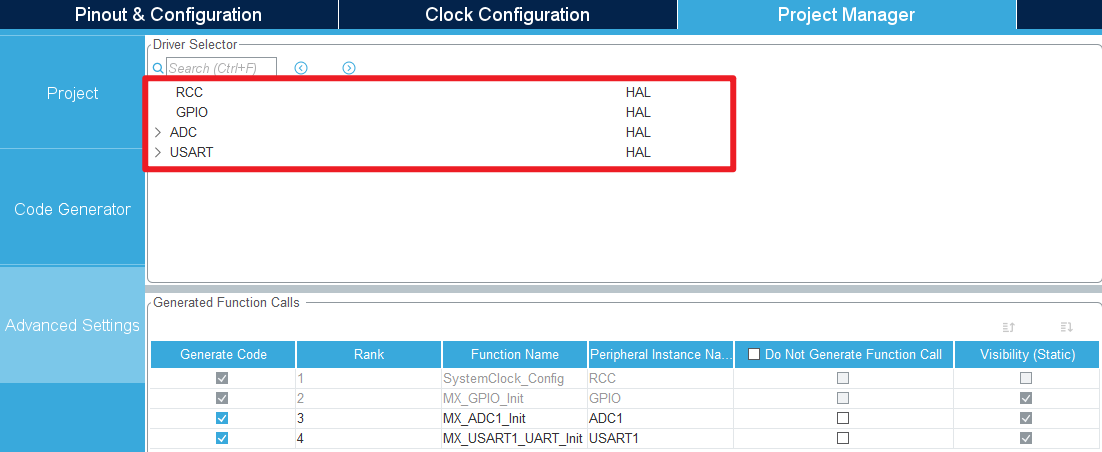
- Generating code

4、Main function
This section mainly introduces the functional code written by users. Detailed code can be opened by yourself in the project file we provide, and enter the Bsp folder to view the source code.
4.1、User function
function:STMFLASH_ReadHalfWord
| Function prototypes | u16 STMFLASH_ReadHalfWord(u32 faddr) |
|---|---|
| Functional Description | Read a half-word (16-bit data) at the specified address. |
| Input parameters | faddr:address |
| Return value | Data for the address |
function:STMFLASH_Write_NoCheck
| Function prototypes | void STMFLASH_Write_NoCheck(u32 WriteAddr,u16 *pBuffer,u16 NumToWrite) |
|---|---|
| Functional Description | Writes data of the specified length from the specified address without checking |
| Input parameters1 | WriteAddr:Start address |
| Input parameters2 | pBuffer:Data pointer |
| Input parameters3 | NumToWrite:Half-word (16 bit) number |
| Return value | None |
function:STMFLASH_Write
| Function prototypes | void STMFLASH_Write(u32 WriteAddr,u16 *pBuffer,u16 NumToWrite) |
|---|---|
| Functional Description | Writes data of the specified length starting at the specified address |
| Input parameters1 | WriteAddr:Start address |
| Input parameters2 | pBuffer:Data pointer |
| Input parameters3 | NumToWrite:Half-word (16 bit) number |
| Return value | None |
function:STMFLASH_Read
| Function prototypes | void STMFLASH_Read(u32 ReadAddr,u16 *pBuffer,u16 NumToRead) |
|---|---|
| Functional Description | Read data of the specified length starting at the specified address |
| Input parameters1 | ReadAddr:Start address |
| Input parameters2 | pBuffer:Data pointer |
| Input parameters3 | NumToRead:Half-word (16 bit) number |
| Return value | None |
4.2、HAL library function parsing
The HAL library functions that were covered in the previous tutorial will not be covered
xxxxxxxxxxIf you want to find the HAL library and LL library function analysis involved in the entire tutorial, you can view the documents in the folder [8. STM32 Manual: STM32F1_HAL Library and LL Library_User Manual]
function:HAL_FLASH_Unlock
| Function prototypes | HAL_StatusTypeDef HAL_FLASH_Unlock(void) |
|---|---|
| Functional Description | Unlock access to the flash control register |
| Input parameters | None |
| Return value | HAL status value:HAL_OK、HAL_ERROR、HAL_BUSY、HAL_TIMEOUT |
function:HAL_FLASH_Lock
| Function prototypes | HAL_StatusTypeDef HAL_FLASH_Lock(void) |
|---|---|
| Functional Description | Lock flash control register access |
| Input parameters | None |
| Return value | HAL status value:HAL_OK、HAL_ERROR、HAL_BUSY、HAL_TIMEOUT |
function:HAL_FLASH_Program
| Function prototypes | HAL_StatusTypeDef HAL_FLASH_Program (uint32_t TypeProgram, uint32_t Address, uint64_t Data) |
|---|---|
| Functional Description | Used for writing data to Flash |
| Input parameters1 | TypeProgram:Type of data written: half-word, byte, or double-word |
| Input parameters2 | Address:The address where Flash writes data |
| Input parameters3 | Data:To write data |
| Return value | HAL status value:HAL_OK、HAL_ERROR、HAL_BUSY、HAL_TIMEOUT |
function:HAL_FLASHEx_Erase
| Function prototypes | HAL_StatusTypeDef HAL_FLASHEx_Erase (FLASH_EraseInitTypeDef *pEraseInit, uint32_t *PageError) |
|---|---|
| Functional Description | A pointer to a FLASH_EraseInitTypeDef structure used to erase a sector in Flash memory |
| Input parameters1 | pEraseInit:Configure the parameters for the erase operation |
| Input parameters2 | PageError:Used to get the sector number of the error in the erase operation |
| Return value | HAL status value:HAL_OK、HAL_ERROR、HAL_BUSY、HAL_TIMEOUT |
5、Experimental phenomenon
After downloading the program successfully, press the RESET button of the development board to open the serial debugging assistant to observe the phenomenon
xxxxxxxxxxFor program download, please refer to [2. Development environment construction and use: program download and simulation]
phenomenon:
Press KEY1: The serial debugging assistant will output the prompt of adding 1 to the count;
Press KEY2: The serial debugging assistant will output the prompt of zero count;
Press KEY3: Serial debugging assistant will read the current count value;
After the development board power off, you can also read the previous count value.
